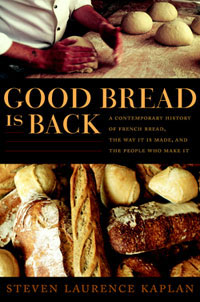
An Excerpt From Good Bread Is Back
December 5, 2007
By Steven Kaplan

Chapter One, Good Bread: Practices and Discourses. Let us go into the narrow, oppressive space of an eighteenth-century
baking room. In Paris, this probably means heading down into an
ill-ventilated basement, lit by the few candles grudgingly granted by
the owner’s wife, who kept the accounts.
 Let us go into the narrow, oppressive space of an eighteenth-century baking room. In Paris, this probably means heading down into an ill-ventilated basement, lit by the few candles grudgingly granted by the owner’s wife, who kept the accounts. Even though the conditions may have already been less difficult in her day, George Sand did not find the expression “dark dungeon” too strong. The work was hard and often mind-numbing. Someone had to prepare wood for the fire, then light it, draw water, handle bags of flour weighing nearly 150 kilos, then knead 100 kilos or more with his hands and sometimes his feet. The baker’s boy responsible for kneading was called le geindre, the groaner, because of the sounds he made while he worked: “A kind of painful cry,” Sand called it, “you’d think you were witnessing the final scene of a murder.” From the worker’s standpoint, this “forced labor” came under the heading of criminal behavior: “Night, a time of rest, is a time of torture for us,” baker’s “boys”—journeymen—complained in 1715, and the refrain was echoed throughout the nineteenth century by others protesting this “nocturnal slavery,” this morally and physically destructive “captivity.”
Let us go into the narrow, oppressive space of an eighteenth-century baking room. In Paris, this probably means heading down into an ill-ventilated basement, lit by the few candles grudgingly granted by the owner’s wife, who kept the accounts. Even though the conditions may have already been less difficult in her day, George Sand did not find the expression “dark dungeon” too strong. The work was hard and often mind-numbing. Someone had to prepare wood for the fire, then light it, draw water, handle bags of flour weighing nearly 150 kilos, then knead 100 kilos or more with his hands and sometimes his feet. The baker’s boy responsible for kneading was called le geindre, the groaner, because of the sounds he made while he worked: “A kind of painful cry,” Sand called it, “you’d think you were witnessing the final scene of a murder.” From the worker’s standpoint, this “forced labor” came under the heading of criminal behavior: “Night, a time of rest, is a time of torture for us,” baker’s “boys”—journeymen—complained in 1715, and the refrain was echoed throughout the nineteenth century by others protesting this “nocturnal slavery,” this morally and physically destructive “captivity.”
In the mid-eighteenth century, bakers’ assistants working for Mistress Lapareillé began their day at 11:30 P.M.; those working for Masters Marreux and Barré started at midnight. Another master worked with his compagnons, or journeymen, almost without interruption from 8:00 P.M. to 7:00 A.M. Constantly on the job, obliged to stop the breadmaking process and start it up again, tormented by a powerful need to rest that they could satisfy only sporadically, the assistants usually slept in the bakeries, as did journeyman Martin Macadrez, who went to bed at 7:00 A.M. “above the oven.” This was the hellish rhythm of a society that lived on bread, that could not get along without it for a moment.
The air in the bakery was heavy, sometimes thick with flour dust and sometimes suffocatingly humid. When the oven was in use, the heat was overwhelming. Apprentices worked in rough underclothing (often made of old flour sacks) and dripped with sweat, enriching (or infecting) the dough.
 Before baking began, especially in winter, the bakery was damp and freezing cold. The environment was as unhealthy as the work was exhausting. Louis-Sébastien Mercier, a chronicler of eighteenth-century Parisian ways, was struck by the contrast between butchers’ boy, who were sturdy, ruddy fellows, and baker’s boy, who could be seen in shop doorways looking wretched, haggard, and pale, like flour-drenched scarecrows. There was just enough room to maneuver and carry out the simplest operations.
Before baking began, especially in winter, the bakery was damp and freezing cold. The environment was as unhealthy as the work was exhausting. Louis-Sébastien Mercier, a chronicler of eighteenth-century Parisian ways, was struck by the contrast between butchers’ boy, who were sturdy, ruddy fellows, and baker’s boy, who could be seen in shop doorways looking wretched, haggard, and pale, like flour-drenched scarecrows. There was just enough room to maneuver and carry out the simplest operations.
Sometimes the workers could barely stand upright.
Reprinted with permission from Good Bread Is Back: A Contemporary History of French Bread, the Way It Is Made, and the People Who Make It, by Steven Kaplan, published by Duke University Press, 2006.
Print this page
Leave a Reply